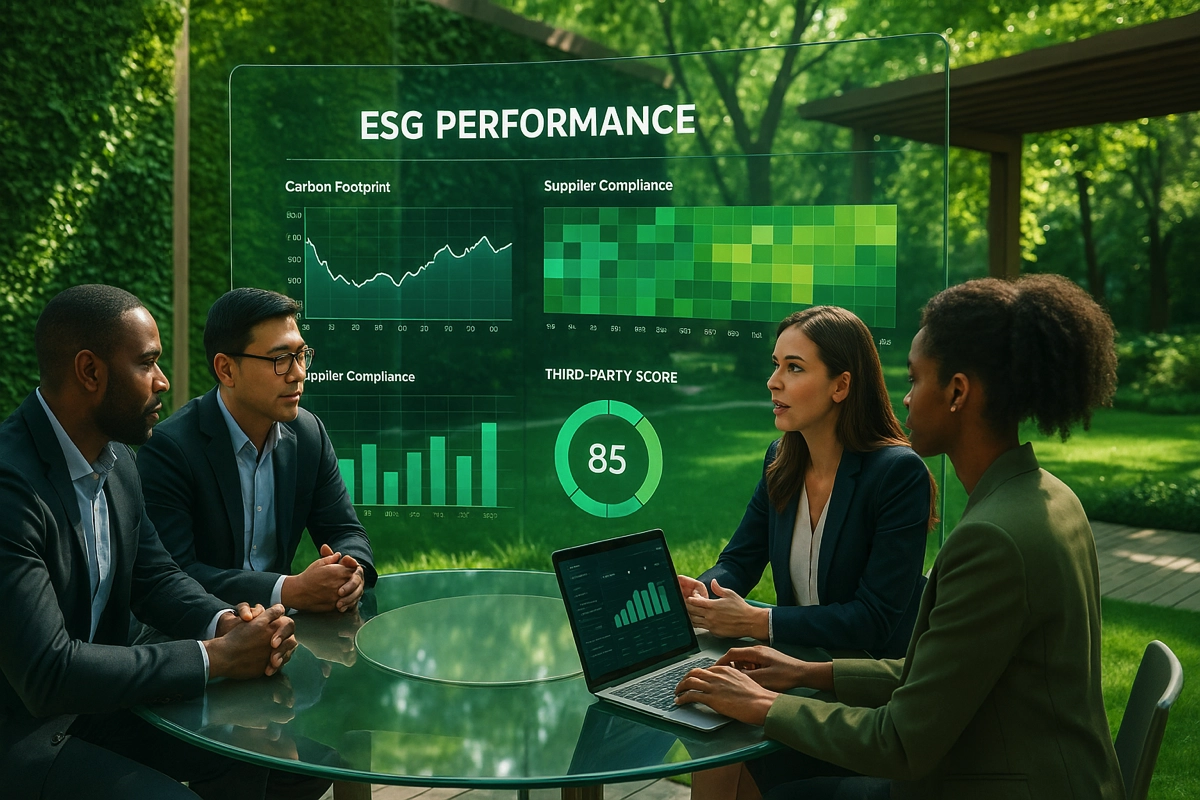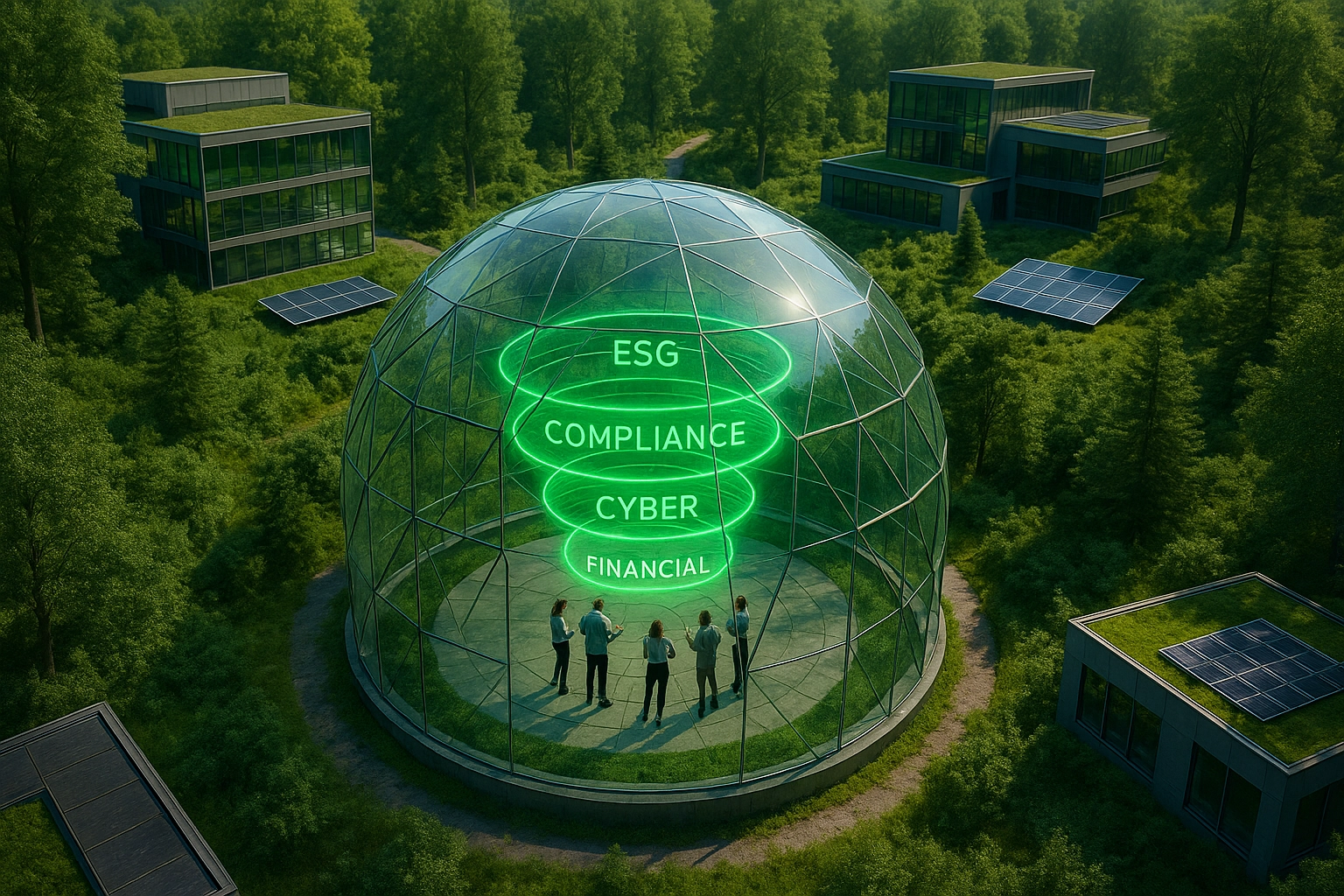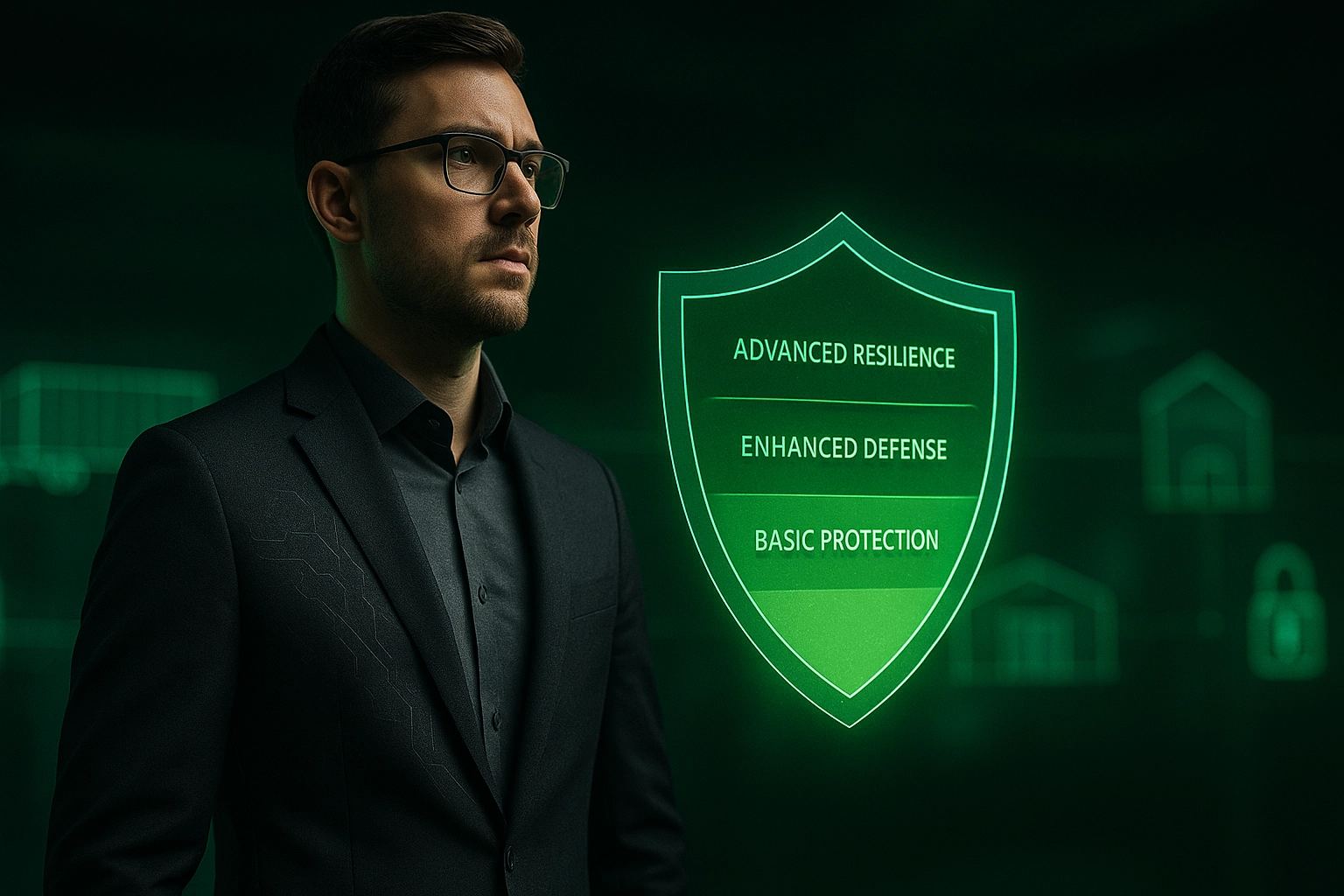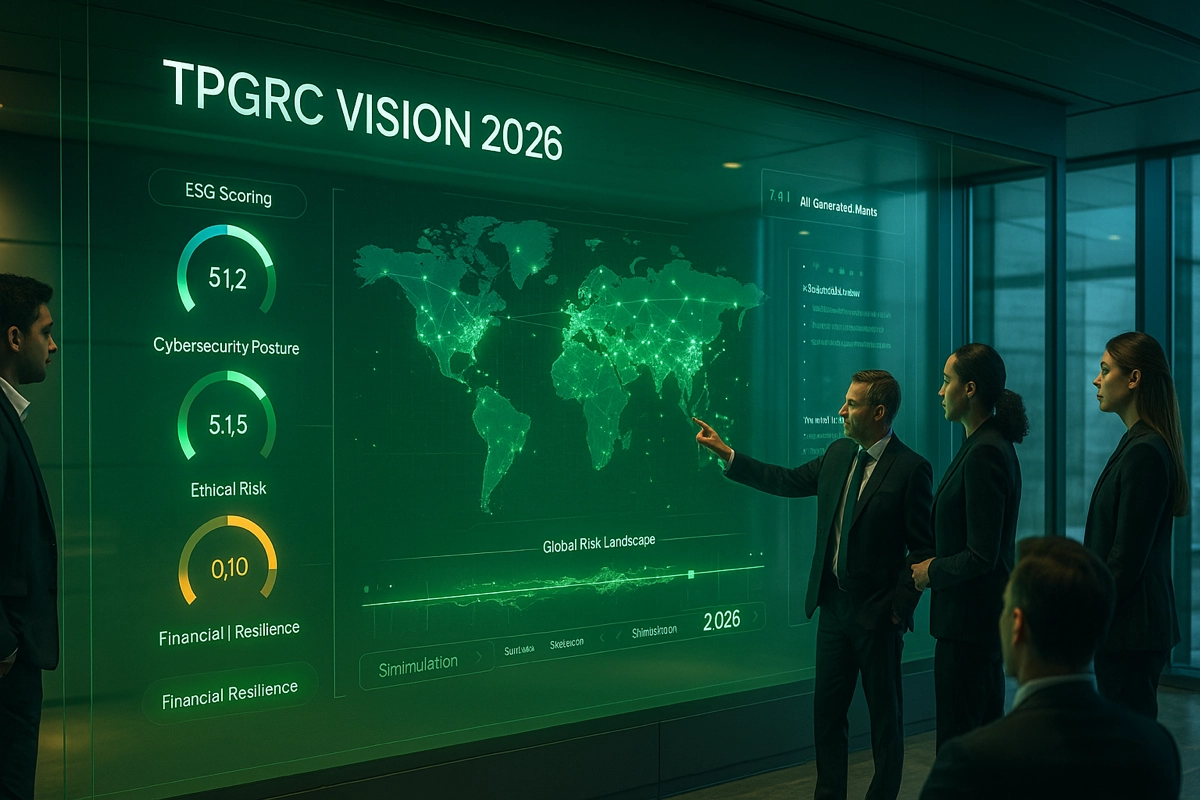ESG Strategy for the Supply Chain: Assessment and Management Methods

The ESG strategy (Environment, Social, Governance) has become a fundamental pillar of corporate operational resilience. According to the 2025 Supply Chain ESG Risk Outlook by LRQA, over half of sourcing countries are now classified as high or extreme ESG risk, challenging the common perception that Western markets are inherently safer. This new reality demands a deep transformation in how companies assess third-party partners throughout their supply chains.
In light of evolving regulations such as the CSRD and the EU Deforestation Regulation, organizations must rethink their third-party governance approach to ensure a responsible supply chain. With more than 450,000 third parties managed globally, Aprovall’s expertise supports this critical transition toward collaborative and proactive ESG risk evaluation.
Why integrate ESG assessments into your supply chain?
ESG diagnostics for external providers are now essential for any organization aiming to sustain its operations. According to the OECD, integrating ESG criteria into supply ecosystem governance significantly reduces third-party risks while increasing operational robustness in the face of disruptions. This approach directly addresses the growing body of regulatory requirements emerging this year.
In the construction sector, material traceability and subcontractor management are key challenges. Collaborative evaluation of ESG practices helps anticipate non-compliance risks that could jeopardize entire construction projects and expose contracting authorities to legal liabilities.
To go deeper into decarbonization and subcontractor management, check out our dedicated report.
The tangible benefits of a successful ESG strategy
Implementing a structured ESG approach across your supply chain yields measurable advantages:
- Enhanced reputation and increased stakeholder trust
- Reduced financial and operational risks from third-party failures
- Cost optimization through better resource management
- Easier access to new markets and sustainable financing
Go Further
The World Economic Forum highlights that companies adopting a proactive ESG evaluation approach for their commercial partners show greater resilience, maintaining business continuity during crises. This increased resilience translates to a 10–15% higher valuation compared to competitors less advanced in ESG implementation.
How to implement an effective ESG evaluation process in the supply chain
A successful ESG program is built upon structured evaluations of strategic suppliers. According to ISO 20400, the process should rely on three main pillars: risk mapping, prioritization of critical partners, and deployment of a collaborative evaluation framework aligned with key challenges.
In industrial sectors, this method supports compliance with ICPE (Installations Classified for Environmental Protection) and REACH (Registration, Evaluation, Authorization, and Restriction of Chemicals). A study by ADEME found that companies using shared evaluation methodologies with their partners saw a 37% decrease in environmental non-compliance incidents in their supply chains.
To prevent “supplier fatigue,” it’s crucial to adopt a mutualized, automated evaluation model. This approach centralizes information and optimizes resources for both the company and its third-party partners. To explore how to implement an ESG evaluation program tailored to your partners, check out our guide.
Engaging stakeholders for full adoption
The engagement and maturity of stakeholders is a determining factor in the success of an ESG strategy for the supply chain. The Business & Sustainable Development Commission notes that organizations co-building their ESG approach with external partners achieve a 65% higher adoption rate.
To maximize engagement, three levers prove especially effective:
- Transparency around objectives and assessment methodologies
- Reciprocity in sharing data and best practices
- Recognition of ESG performance as a competitive differentiator
This participatory model transforms ESG audits into a true driver of shared performance.
Focus: Decarbonization
Did you know? Nearly 80% of carbon emissions stem from suppliers. Scope 3 measurement is now high on the agenda, often handled by Procurement teams. This measure is closely tied to supplier assessments and their maturity in reducing carbon footprints. It’s vital to integrate supplier evaluation processes capable of capturing this information.
Key ESG regulations: plan ahead
In today’s context, multiple major ESG regulations directly impact third-party governance. The Corporate Sustainability Due Diligence Directive (CSDDD) and the Corporate Sustainability Reporting Directive (CSRD) significantly expand companies’ responsibilities across their supply chains. According to Deloitte, 49% of European companies were unprepared for these new transparency and due diligence requirements.
To manage CSRD compliance and structure your third-party governance, see our article on Aprovall’s CSRD-related challenges.
These regulations reflect the urgency of environmental challenges facing businesses in 2025. The EU regulation on deforestation now mandates full traceability for products from high-risk zones, while the EU green taxonomy redefines sustainable investment criteria. As the EFRAG report notes, organizations must demonstrate deep mastery of environmental issues throughout the value chain, including the practices of third-party partners.
In the retail sector, these regulatory shifts demand in-depth assessments of ESG practices across marketplaces and international suppliers. The European Commission estimates that companies must ensure full traceability for over 70% of their sourcing.
To anticipate these requirements, organizations must deploy assessment tools tailored to industry needs and capable of real-time ESG data analysis.
Ongoing optimization through best practices
Continuous improvement of ESG evaluation processes relies on the adoption of innovative technologies. The World Economic Forum highlights that AI-powered document analysis can boost compliance control efficiency for strategic suppliers by 60%.
To ensure a resilient value chain, three best practices stand out:
- Continuous monitoring of ESG performance indicators
- Collaborative evaluation using shared frameworks
- Data pooling to reduce administrative burdens
These methods—supported by secure, sovereign digital infrastructure—form the foundation of a long-term ESG strategy for the supply chain. A robust measurement framework is now essential to capture and highlight progress.
Take action today!
Request a personalized demo of Aprovall360 to streamline your third-party ESG assessments.
Measuring and supporting transformation toward a sustainable future
Measuring ESG performance among third-party partners is now a strategic indicator for responsible organizations. According to the UN Global Compact, companies systematically incorporating ESG diagnostics into third-party governance achieve 42% greater resilience during supply chain disruptions.
In the public sector, this transformation is a key lever for achieving sustainable development goals. The Fédération des EPL (Local Public Companies) reports that integrating ESG criteria into public tenders has reduced local authorities’ carbon footprints by an average of 23%, while also amplifying the social impact of projects.
Moving from basic risk management to collaborative governance of external providers requires three core components:
- Relevant performance indicators tailored to each sector
- A secure evaluation platform supporting ESG and other risk domains (financial failure, legal, ethical)
- Customized support for partner progress
This comprehensive approach not only ensures regulatory compliance but also anticipates future developments. As BSR (Business for Social Responsibility) points out: “Organizations that make ESG evaluation a pillar of their supply chain strategy in 2025 won’t just manage risks—they’ll create shared value and build sustainable competitive advantage.”
Thus, building a responsible supply chain is no longer just aspirational—it’s a concrete reality for forward-thinking organizations. The ESG approach deployed today within your supply chain will shape your ability to thrive in a world where environmental, social, and governance excellence is a must. This collective goal is the new standard for building strong, future-ready relationships with third-party partners.
Need tailored support to structure your ESG approach?
Contact our experts for a personalized supply chain assessment.
These articles might interest you
-
 16 January 2025TPRM Platform: Essential Features for Modern Third-Party Risk ManagementSolutionsAs third-party risk management becomes a strategic priority, TPRM platforms (Third Party Risk Management) are emerging as a must-have standard. This shift responds to a dual imperative: ensuring operational continuity and meeting increasingly complex multi-country regulatory compliance. With over 430,000 third-party vendors assessed across Europe, Aprovall’s experience has helped define the essential features of a modern TPRM platform—now evolving into a broader […]
16 January 2025TPRM Platform: Essential Features for Modern Third-Party Risk ManagementSolutionsAs third-party risk management becomes a strategic priority, TPRM platforms (Third Party Risk Management) are emerging as a must-have standard. This shift responds to a dual imperative: ensuring operational continuity and meeting increasingly complex multi-country regulatory compliance. With over 430,000 third-party vendors assessed across Europe, Aprovall’s experience has helped define the essential features of a modern TPRM platform—now evolving into a broader […]Read more
-
 06 February 2025Effective Third-Party Governance: A Holistic Approach to Optimized Risk ManagementSolutionsIn a context where 38% of companies have experienced major disruptions due to third-party partners over the past three years, third-party governance is becoming a strategic imperative. This reality is even more critical as 90% of organizations now consider third-party risk management a growing priority. Effective third-party management relies on a holistic approach integrating six key areas of expertise: Legal […]
06 February 2025Effective Third-Party Governance: A Holistic Approach to Optimized Risk ManagementSolutionsIn a context where 38% of companies have experienced major disruptions due to third-party partners over the past three years, third-party governance is becoming a strategic imperative. This reality is even more critical as 90% of organizations now consider third-party risk management a growing priority. Effective third-party management relies on a holistic approach integrating six key areas of expertise: Legal […]Read more
-
 17 March 2025Understanding Third-Party Cybersecurity Maturity: Keys to Effective AssessmentSolutionsThird-party governance has become a major strategic issue in an economic context marked by the growing interdependence between companies and their external partners. According to Gartner, 45% of cyberattacks in 2025 will originate from third parties, highlighting the urgency of a structured evaluation approach. Operational resilience against these threats now requires a shift from simple […]
17 March 2025Understanding Third-Party Cybersecurity Maturity: Keys to Effective AssessmentSolutionsThird-party governance has become a major strategic issue in an economic context marked by the growing interdependence between companies and their external partners. According to Gartner, 45% of cyberattacks in 2025 will originate from third parties, highlighting the urgency of a structured evaluation approach. Operational resilience against these threats now requires a shift from simple […]Read more
-
 30 September 2025TPRM Visions 2026: Expanding the Evaluation Spectrum to Anticipate Emerging RisksSolutions2026: A Turning Point in Third-Party Evaluation Third-party management is undergoing a major transformation. Until now, companies have focused their evaluations on the most immediate risks: supplier financial stability, ethical compliance, and fraud prevention related to banking information. These areas remain critical. But by 2026, TPRM (Third Party Risk Management and Compliance) will broaden its scope to […]
30 September 2025TPRM Visions 2026: Expanding the Evaluation Spectrum to Anticipate Emerging RisksSolutions2026: A Turning Point in Third-Party Evaluation Third-party management is undergoing a major transformation. Until now, companies have focused their evaluations on the most immediate risks: supplier financial stability, ethical compliance, and fraud prevention related to banking information. These areas remain critical. But by 2026, TPRM (Third Party Risk Management and Compliance) will broaden its scope to […]Read more
